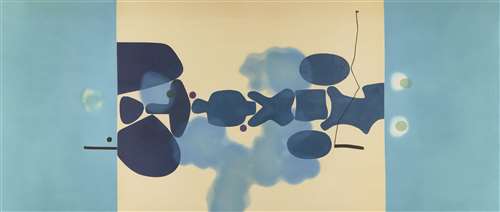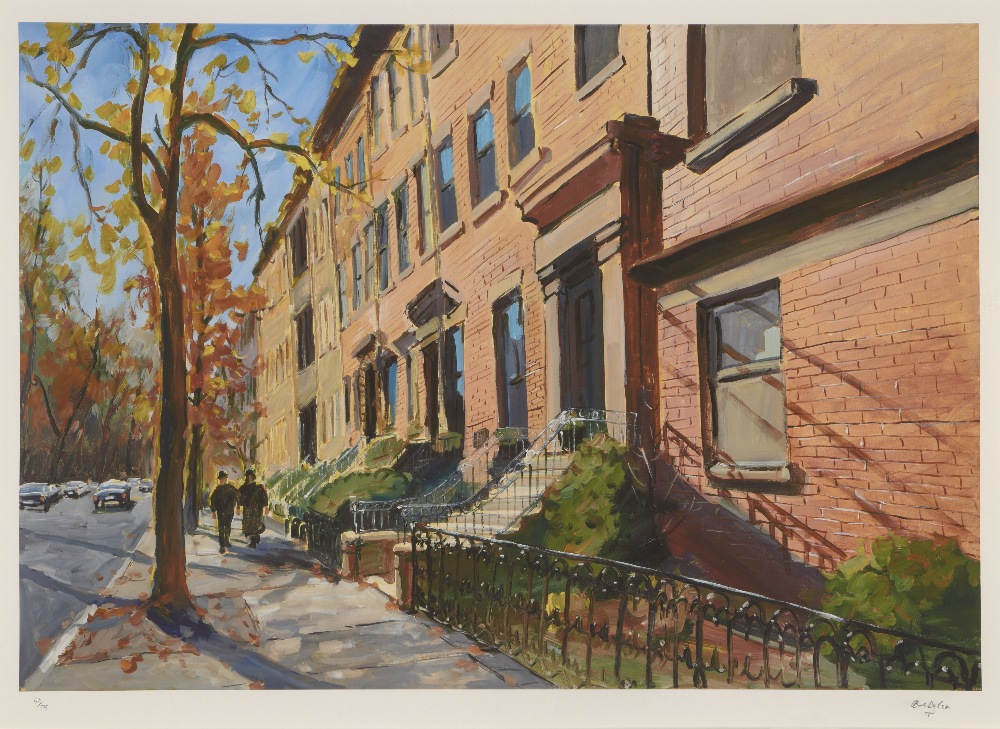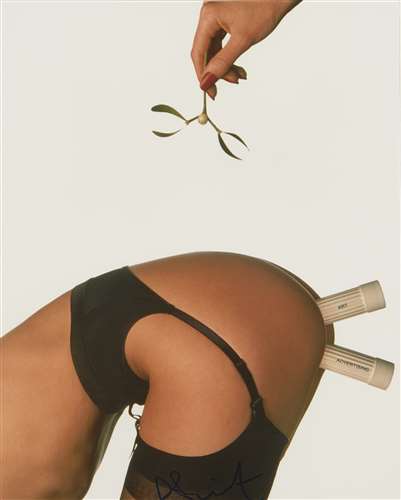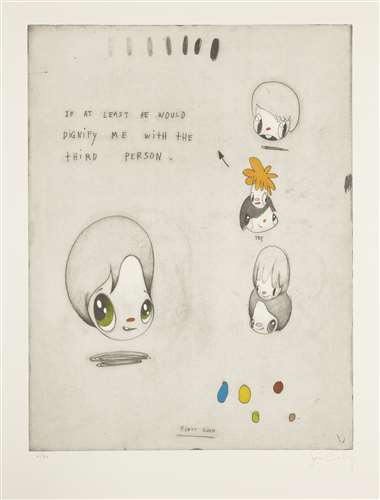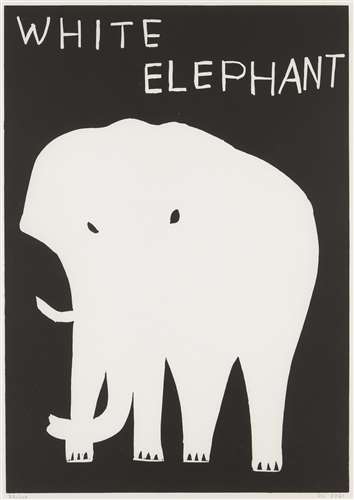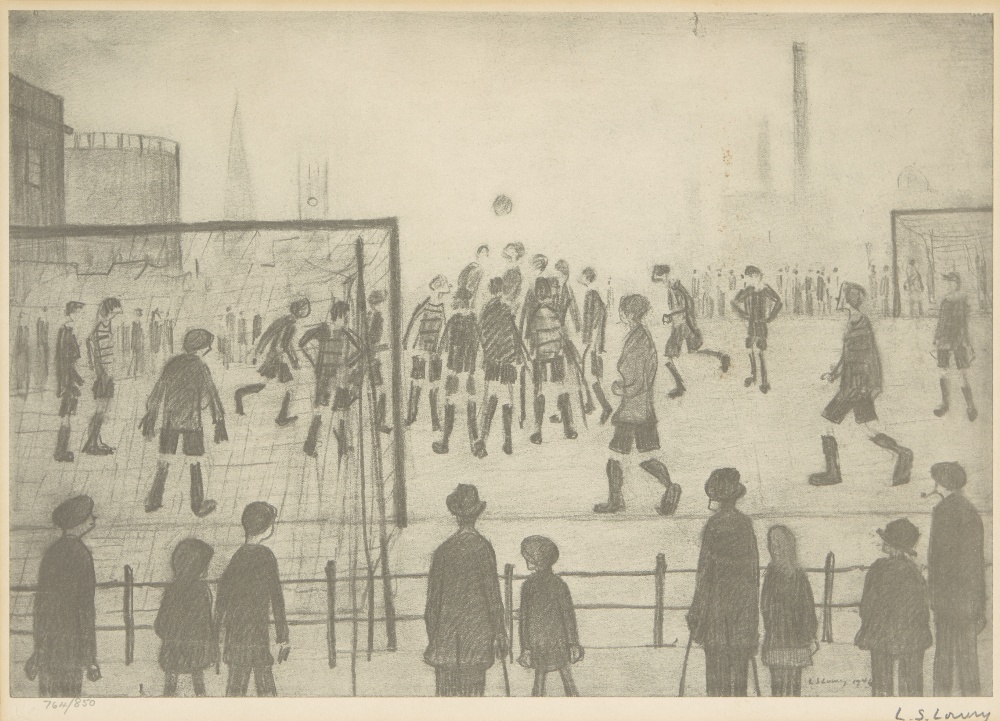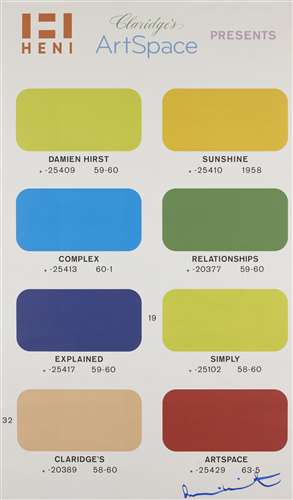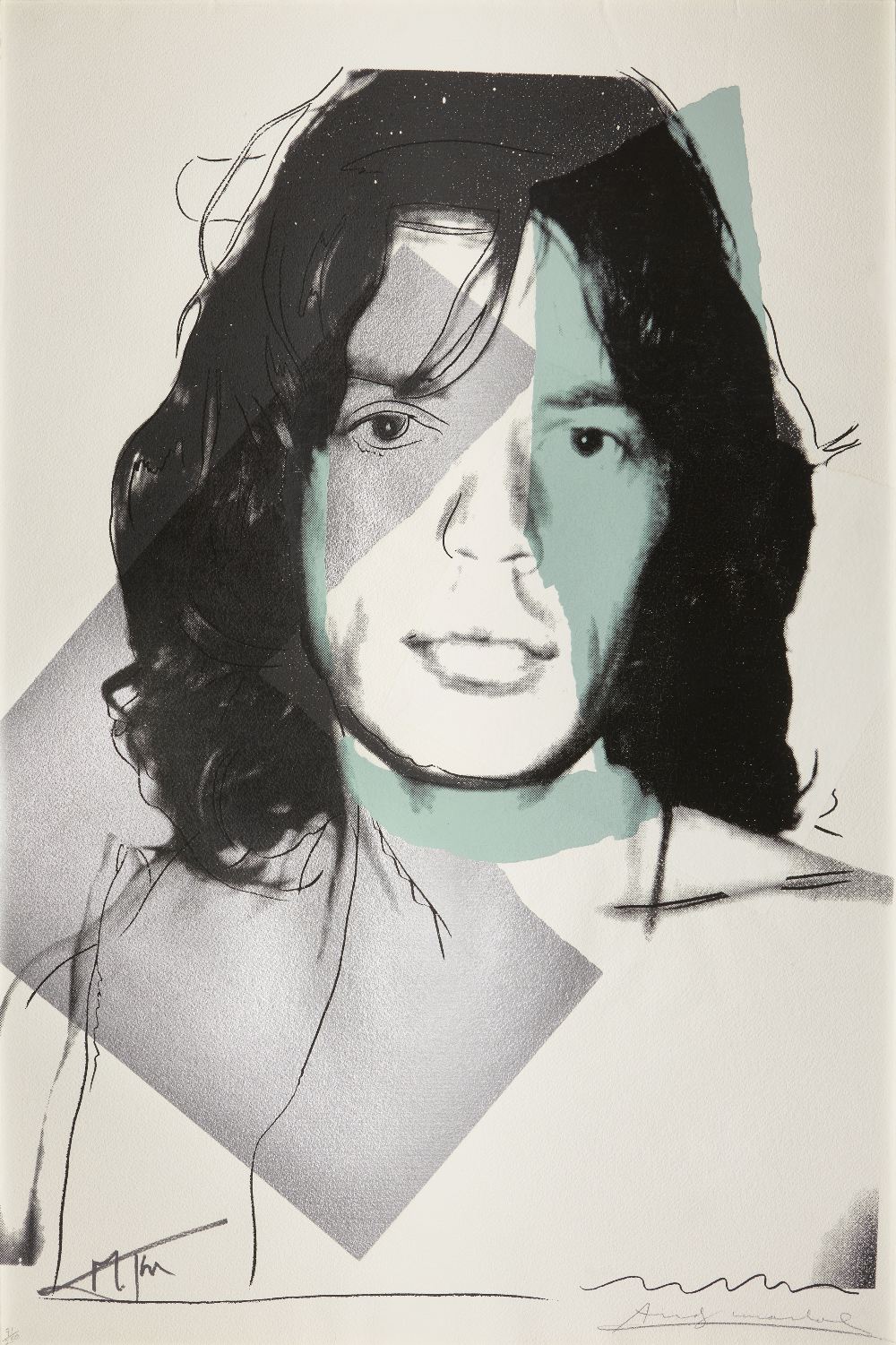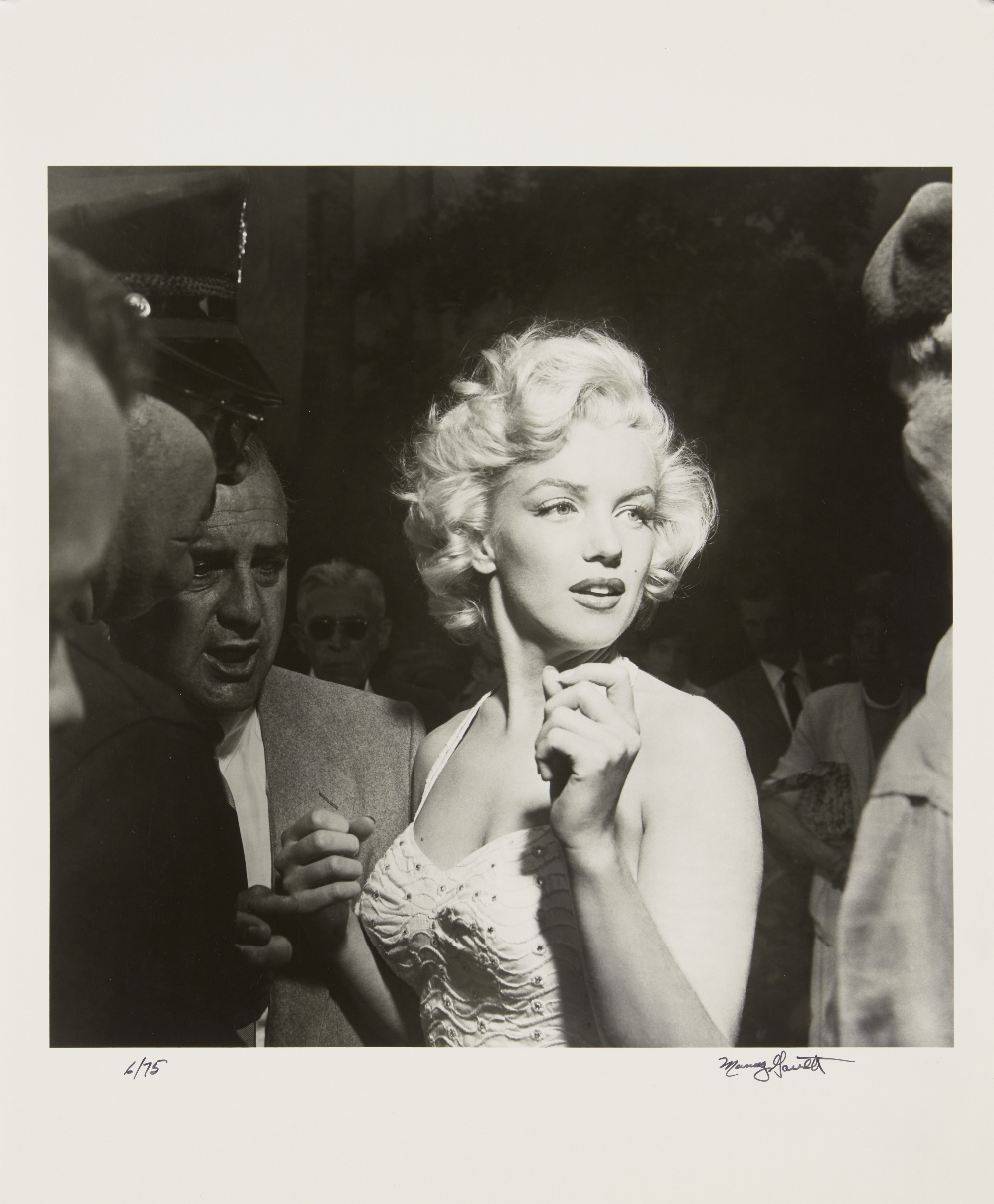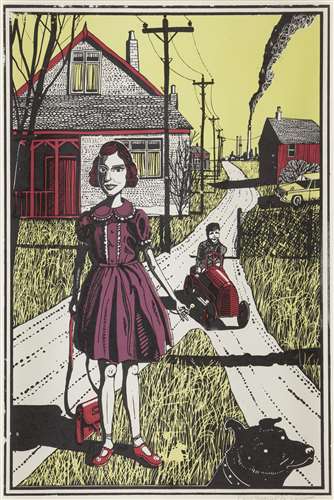For each auction, we ask a department specialist to guide us on how to start building a collection. On this occasion, we spoke with Madeleine White, Associate Specialist who introduced us to the different types of prints and terminology around editions.
You can browse the catalogue for the upcoming Prints & Multiples auction here.
Aquatint
An intaglio printing technique. This is used, not for line, but for tonal shapes. The plate is covered with tiny particles of rosin which is then heated until the rosin begins to melt on. It is then placed into an acid bath where the acid will eat away at the tiny areas of exposed metal between the specks of rosin. This version of biting creates large areas of incision, so when the plate is inked and printed, planes of colour emerge. To incise specific shapes onto the plate, an artist can use liquid stop out to block out areas of the composition.
Lot 314: Victor Pasmore CH CBE, British 1908-1998,The Pulse, 1985
AP- Artist’s Proof
Made by the artist to check the print quality and design before printing an edition. Artist’s Proof prints usually shouldn’t exceed 10% of the overall number in the edition. They are usually identical to the edition but may sometimes include slightly flawed prints omitted from the edition. These examples are set aside for the artist to keep or gift- this can also be numbered (AP 1/5).
Archival Pigment Print
Photographic print made by a digital inkjet printer. As opposed to consumer level printers which used dye based inks (where the colourant fully dissolves in liquid), fine-art/photographic printers use pigment-based inks (where the powdered substances are suspended in liquid). This pigment more stable than those in pigment prints and can stand up to light for over 100 years.
Lot 114: Bob Dylan,American b.1941- Brooklyn Heights, from the series The Beaten Path, 2019
BAT- Bon à tirer
(Good to pull)- – The first perfect print to come from the printing surface. This is used to show the print from which the whole edition should be matched.
Carborundum Print
A collagraph process in which the image is created directly on the plate by applying an abrasive grit (Carborundum) mixed with an acrylic medium or glue. Once dried, it forms areas of texture or line which is then inked intaglio, relief or both.
Chine Collé
Where the image is transferred onto a surface that is bonded onto a heavier support in the printing process.
Collagraph
A relief printing technique. Rather than cutting away from a surface, items are collaged onto the surface in order to create different textures.
C-type – Chromogenic Print
Using LED or lasers, the printers project an image onto chemically treated paper which contains light-sensitive silver crystals. These should last about 60 years of light exposure (more than pigment prints but less than archival pigment prints).
Lot 328: Damien Hirst, British b. 1965- Ho, Ho, Ho, 2001
Deckled edge
The irregular, untrimmed edge of handmade paper, often used for ornamental, now often produced artificially on machine-made paper.
Digital print
The use of an inkjet printer to print a reproduction of a digital-based image. This process does not require the use of press plates.
Drypoint
A method of engraving which creates a rough ridge of displaced metal thrown up on each side of the furrow, this is called the burr. This results in a characteristic soft fuzzy line caused by ink printed from a burr.
Edition
A set of identical prints taken from the same printing surfaces. Editions can either be limited or open.
Emulsion
When mixed with sensitiser, a photo emulsion can be used to coat screens to create exposed images for screen printing.
Engraving
An intaglio printing technique. A design is carved into a metal plate by hand. Ink is applied to the plate and then the surface is wiped so that ink only remains in the groves the artist has made. Paper is applied and the plate and paper are then passed through a printing press which forces the paper into the grooves to collect the ink.
Etching
An intaglio printing technique. A metal plate s covered with a thin wax-like layer called the ground. The design is then drawn onto the plate with a needle, removing the ground in these areas. The plate is then submerged into a bath of acid which bites into the areas of drawing where the protective ground has been removed. The ground is removed, the plate inked, paper laid and then it is passed through a printing press. This technique allows you to achieve a range of shallow and deep grooves; where an incision is shallow, the ink will be more faint, and where the incision is deeper, the ink will be more prominent.
Lot 391: Javier Calleja, Spanish b.1971- First Look, 2021
Foxing
Brown spots on the paper as a result of tiny flecks of iron present in the paper-making process rusting over time.
Giclée
A digital print which uses an inkjet printer to produce a high-quality archival pigment print.
HC- Hors Commerce
(Outside the trade) these examples are pulled aside from the numbered edition for internal reference.
Intaglio
A printing process where the incised areas of the plate hold the ink and creates the image, whereas the raised areas become negative space.
Japan/Hand Made paper
Long-fibred hand-made paper with high rag content.
Laid Paper
Paper which has fine ridges to the surface. This is most commonly seen in 19th century and earlier papers. The moulds for this paper use wider vertical and horizontal spacing which leaves a pattern on the paper.
Limited Edition
An edition that has a limited output to a fixed number of works.
Linocut
A relief printing technique developed from woodcut where a sheet of linoleum is used instead of wood.
Lot 367: David Shrigley OBE, British b. 1968- White elephant, 2021
Lithography
This planographic technique is based on the immiscibility of oil and water. A design is drawn onto a flat stone or prepared metal plate using an oil-based crayon or ink. The surface is then prepared for inking using a series of chemical reactions. Once inked, a damp sheet of paper is laid on the surface and both the stone/metal sheet and paper are passed through a press.
Mezzotint
A print made from an engraved metal plate, the surface of which has been texturised with small incisions (often made by a rocker) to create more subtle tonal shifts between light and dark areas.
Monotype
A printing technique where only one impression has been created. While there are many methods for creating a monotype, one commonly used is coating the glass in printing ink with a roller. Once the surface is covered, areas of ink are wiped away to create an image. The glass is laid onto paper and the reverse of the glass is firmly rubbed.
Offset lithograph
The digital file is broken down to the basic colour separations, CMYK. These separated designed are then laser printed on to four separate aluminium plates. Three sets of rollers form one unit for a single colour. The aluminium plate is attached to the top roller. Single sheets of paper are passed between the second and third roller, where the paper is actually printed. This process helps get a clearer and sharper image than digital printing. This sheet of paper is then passed to the next set of rollers with a different colour. The same process is repeated three more times, allowing the entire print with all the colours to get transferred to the paper.
Lot 5: Laurence Stephen Lowry RBA RA, British 1887-1976
Open Edition
An unlimited run- an artist may create a design they wish to continually publish whether signed or unsigned.
Pigment Print
Photographic print made by a digital inkjet printer. As opposed to consumer level printers which used dye based inks (where the colourant fully dissolves in liquid), fine-art/photographic printers use pigment-based inks (where the powdered substances are suspended in liquid). This pigment is sensitive to light, so colours can fade or shift over time.
Planographic Printing
Printing from a flat surface, as opposed to a raised surface (as with relief printing) or incised surface (as with intaglio printing).
Poster
Most often describes an offset lithographic print on thin, smooth paper.
Lot 327: Damien Hirst, British 1965- Sunshine, 2021
PP – Printers Proof
A prototype to provide an accurate representation of how the design will look when printed.
Relief Printing
A printmaking process where the unwanted areas of a block are carved away. The raised areas are inked and printed.
Risograph
An automated screenprinting process which can maintain it’s quality through many uses because their stencils (or ‘master copies’) are made by burning an image onto a thermal plate.
Screenprint
A mesh screen is used to apply coloured ink to the areas of the screen not blocked out by a stencil, and then this ink is transferred to the paper or material.
Lot 97: Andy Warhol,American 1928-1987,Mick Jagger [F. and S. II.138], 1975
Silver Gelatin Print
Developed in a darkroom due to the print being activated by light (latent printing). The image consists of silver metal particles suspended in a gelatin layer. The print is made by applying an emulsion of light-sensitive silver salts in gelatin to a sheet of paper coated with a layer of baryta, a white pigment mixed with gelatin. The sensitized paper is exposed to light through a negative and then developed out (made visible in a chemical reducing solution).
Lot 176: Murray Garrett, American b.1926- Marylin Monroe
TP – Trial Proof
These prints are made during the process of adjusting and developing the image.
Woodcut
A relief printing technique. An image is carved into a wooden block. The non-printing areas are cut out. Ink is applied to the block and then transferred onto paper.
Wove Paper
Machine made paper which has a flat uniform surface and is the most common type of modern paper. It is called wove because the wires used to mould the paper are tightly woven.


